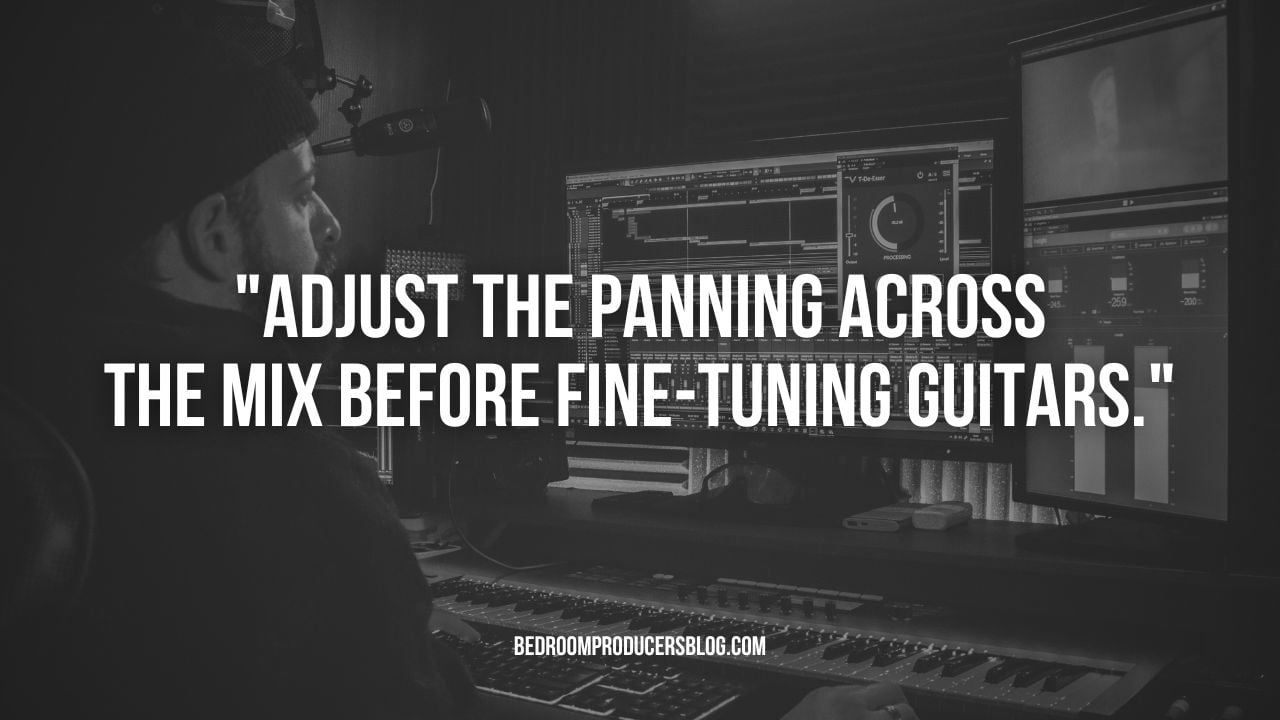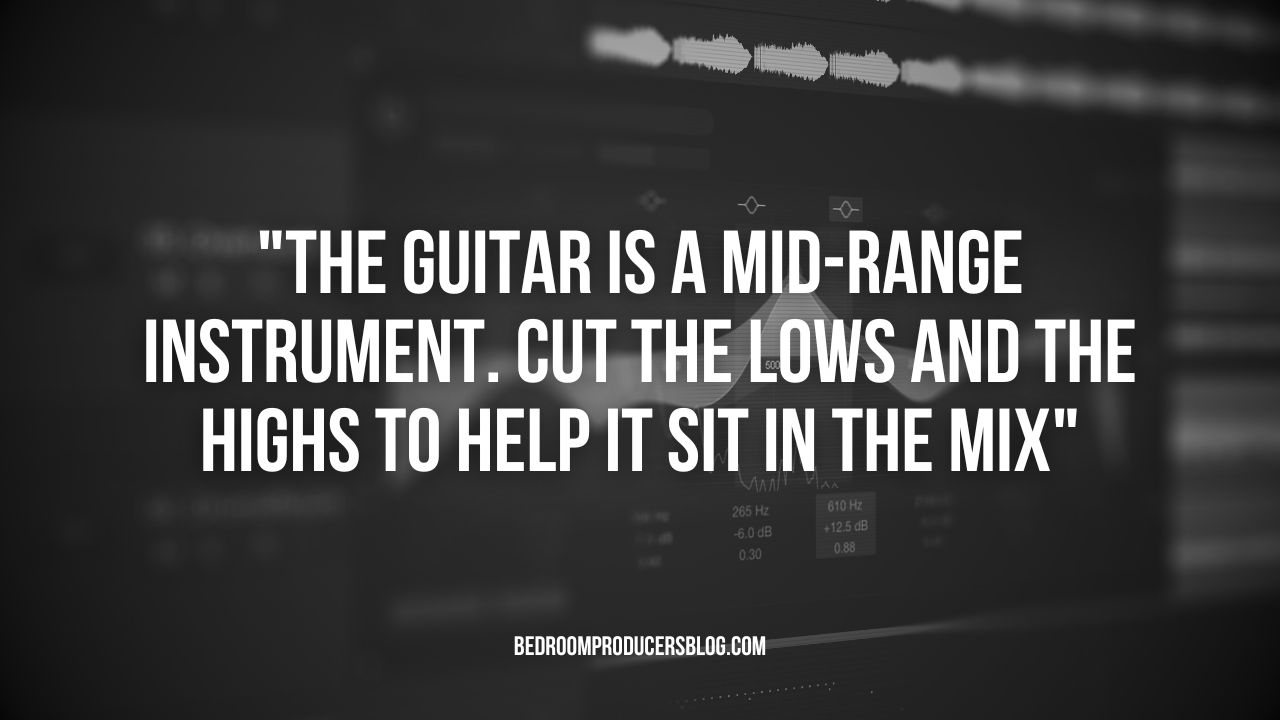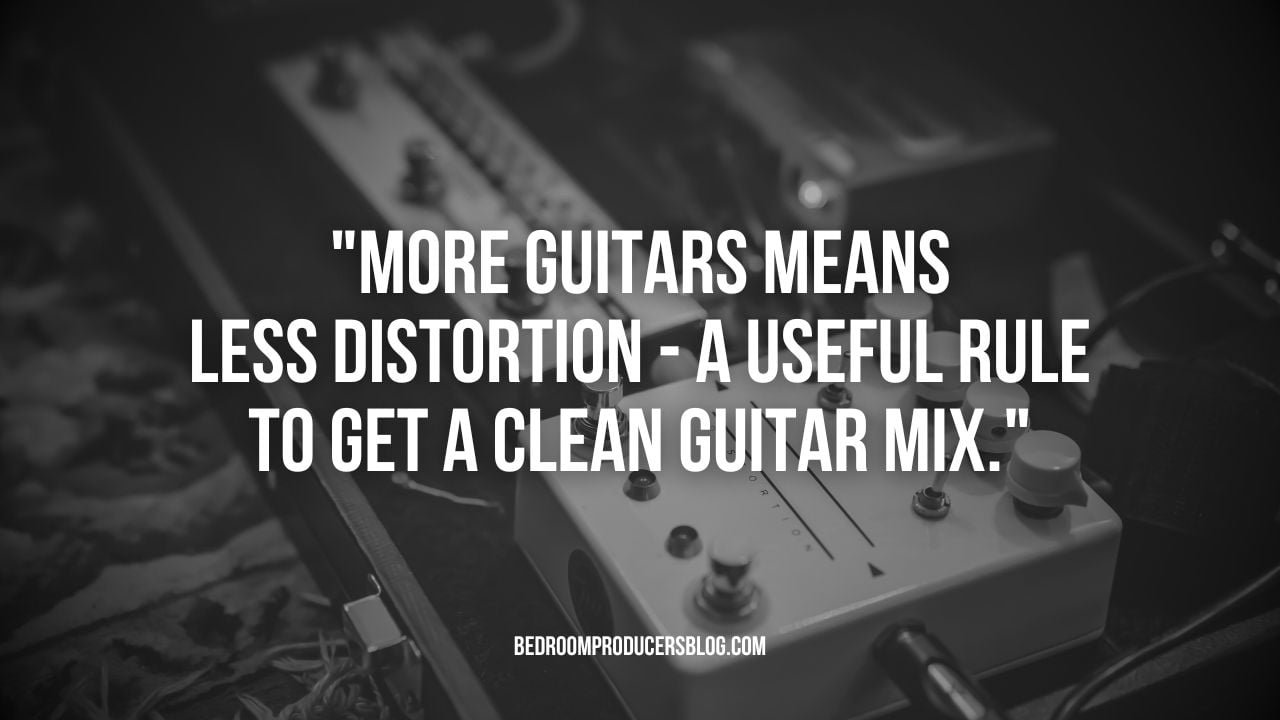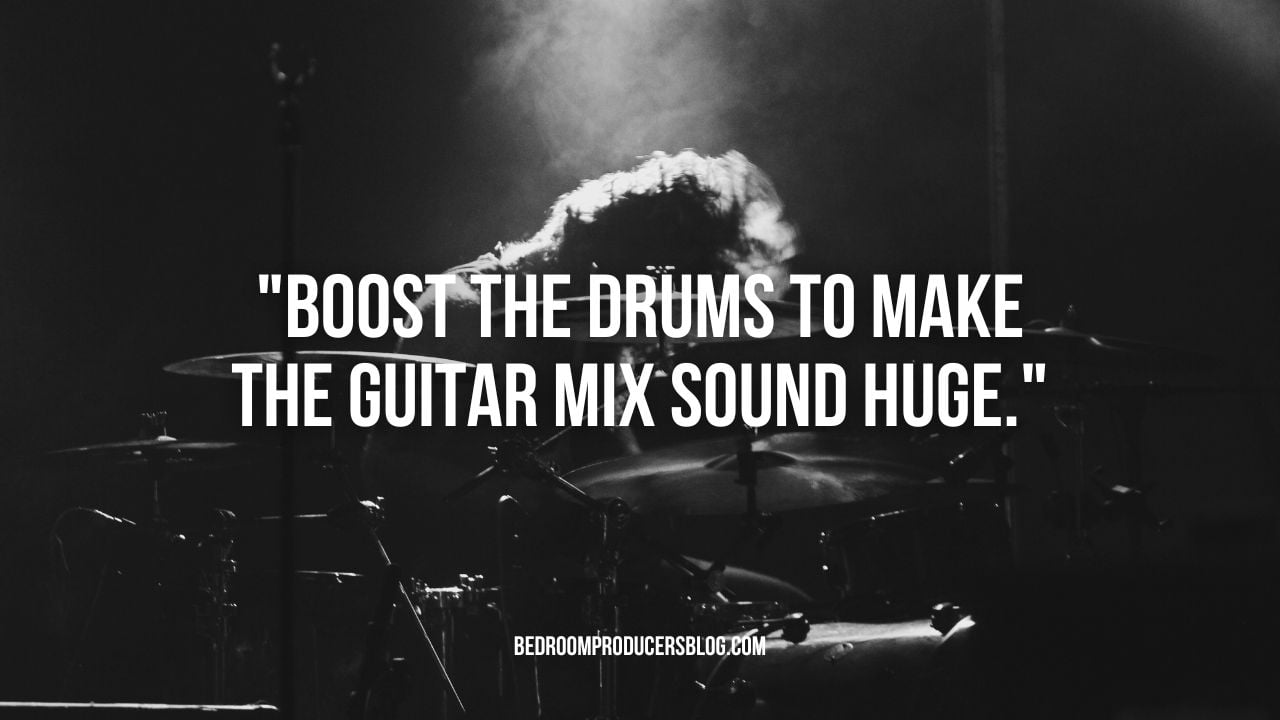Mixing guitars is such a deep topic that there’s always something new you can learn to help get bigger, phatter guitar tracks.
Our guitar mixing tutorial will help you get the guitar sound in your head out into the mix quickly and efficiently.
#1 Pan first, detailed guitar mix work last
One excellent tip for mixing guitars is to start by setting the pans on all your mix channels. After that, get each of them to sound roughly how you want them to sound (in terms of tones and plugins), and only then start making the finer adjustments on individual guitar tracks.

Why? If you start doing the fine detail work on your guitar part when nothing is panned yet, then once you pan and mix the other parts, you’ll have to redo all the fine work again on the guitar part.
This is because the guitar part will sound totally different once everything else has been so heavily adjusted. So save yourself the trouble and get the rough pan and sounds right on everything before doing the mixing surgery.
#2 Clean up your guitar parts with EQ cuts
The guitar is a mid-range instrument, so when mixing guitars, EQ cuts on the low-end and possibly on the high-end can help the tracks sit much better in the mix.
You’ll usually want to cut the lows approximately between 80 and 150 Hz to remove unwanted noise and cut the highs above 10 to 12 kHz to eliminate useless fizz.

Such cuts enable the bass guitar and kick drum to fill out the low-end as they should, without competing with an unnecessary boomy low-end on the guitar, muddying things up.
The same is true for letting the vocals and cymbals have room to shine in the high-end.
If you listen to some isolated guitar tracks of legendary songs on YouTube, the individual guitar tracks are often surprisingly thin-sounding, particularly the leads and solos. This is because the engineer kept the big picture in mind when setting the EQ.
#3 EQ sweep guitar tracks to find trouble spots
To find trouble spots with your EQ, sweep around with a sizable boost (or cut) with a narrow Q to find the offending frequencies.
Using the audition function on an EQ which only plays the frequencies within the Q is also very useful to use in tandem with this process.
As a starting point, you can use the following as a very rough EQ guide for electric guitar:
- 80 Hz and below: Cut the rumble
- 100 Hz – 350 Hz: Can add warmth and fullness
- 2-3 kHz: Pick sound. Also a potential area for harshness.
- ~4kHz & ~6 kHz: Nails on chalkboard & static. May benefit from surgical cuts.
- 10 kHz+: You may want to cut above this, no fundamentals
#4 Compression: Strictly optional on distorted guitars
Compression is a very handy tool for clean guitars to make them stand out in a mix, as they’ll often struggle to do so without it. For funky clean guitar parts, in particular, it’s a key tool to get them to cut right.
But for distorted or overdriven guitars, compression is very much optional.
Compressing distorted guitars can indeed be useful for certain applications. You can use a comp with a fast attack to even out playing dynamics where required.
Or you can use multiband compression on heavy guitars to tame the low-end and low mids. This is an alternative approach to using EQ for this task but using a compressor is more responsive to the playing rather than a one-size fits all EQ cut.
But don’t just automatically slap on a compressor on distorted guitars like you might for drums. Distortion itself already heavily compresses the guitar track, so unless you’re trying to achieve a specific result by using compression, you may want to leave it off.
#5 Work out how many tracks are needed
If you want to know how to make guitars sound bigger in a mix, one of the key tricks is arranging multi-tracked guitars correctly.
What is required here will depend on the details of your song. If it’s a lighter song with piano and strings, then perhaps a single guitar track will suffice.
Most modern songs will have multiple guitar tracks, however. A typical guitar-based song would have dual rhythm guitar tracks panned left and right and perhaps dual lead guitar tracks, in addition to a single guitar solo track.

When double-tracking guitars, you’ll want to go easy on the distortion.
The typical rule is the more guitars, the less distortion.
This guitar mixing tactic allows you to retain clarity in the mix. If you bump up the gain too much, the entire song will become a big fizzy mess.
You can save time by putting any effects you want to add to these multiple guitar tracks onto a bus.
#6 Don’t overdo the distortion
More distortion is always better, right? 🤘
Well, not quite. While playing live, you can probably get away with going ham on the gain. In the cold light of the studio, your mix will benefit from taming your inner Spinal Tap.
When recording distorted guitars, adding gain adds thickness to a point But, beyond that, it just adds fizz and robs the mix of definition and power.
A good general rule is to add as much distortion as is strictly necessary to get the tone and sustain you want, but not any more beyond that.
Think of a record with truly great and huge-sounding guitar tracks. If you listen to it closely, a lot of the time, you’ll find the level of distortion used is not all that crazy.
#7 Secret guitar mixing sauce: Make the drums loud!
If you want to know how to make guitars sound bigger, here’s a secret: Mix the drums loud!
It may sound counter-intuitive, but having the guitars be the loudest thing in the mix actually just makes everything else sound weak rather than making the guitars sound huge.

And by “mix the drums loud,” I mean the drums, like kick, snare, and toms. Having loud cymbals often just adds noise rather than making things sound big.
Still not convinced?
Listen to a song produced by a guitarist, like Dream Theater’s “False Awakening Suite” from their 2013 self-titled record. The guitars overpower everything, making the drums sound tinny and unimpressive.
Compare that to Dream Theater’s “The Dance of Eternity” from Metropolis Pt 2: Scenes from a Memory, when the drums are mixed nice and loud, and the guitars are at a more reasonable volume. Which song sounds heavier?
Or, for the ultimate example of how loud drums can make guitars sound huge, just put on Metallica’s “Sad But True.”
#8 Busses = better workflow
Busses involve you sending multiple individual channels together into a single auxiliary channel. Then you can apply plugins to that single bus that affects each of the individual channels at the same time.
When mixing guitars, this is very useful as effects that you want to add to multiple guitar tracks. You can simply send them to a bus and add the effect there.
This improves your workflow and enables making changes to your guitar tracks a lot more efficiently, as well as using fewer CPU resources.
#9 Different tones = more depth
If you’re wondering how to make guitars sound bigger, one trick to add depth and power to multi-tracked mixes is by varying the tones and effects on each guitar track.
You can even change out guitars and amps for more variety.
Having different tones on different guitar tracks (for example, on a left and right rhythm track) sort of tricks the ear into perceiving the whole thing as bigger and wider.
#10 Sack the solo button to get a balanced guitar mix
This is a big one. When mixing guitars, don’t solo the guitar part and go to town. You want to spend most of your time mixing within the context of the full mix.
Why? Because you need to be able to see the forest from the trees.
You can spend an hour tooling away at a soloed guitar track until it sounds like James Hetfield on steroids, but when you take it off solo, it will sound nothing like what it sounded like before and often won’t work that well within the mix.
This is because when you’re working on a soloed track, you have the full frequency range to work with. But once you have the full mix in, the low and high end will start fighting with other instruments in the same frequency range, and you’ll lose the power of the soloed track.
Do you have any additional guitar mixing tips you’d like to share with fellow BPB readers? Feel free to post them in the comments section below.
Return to our mixing music guide for more information.
Last Updated on May 1, 2023 by Tomislav Zlatic.







